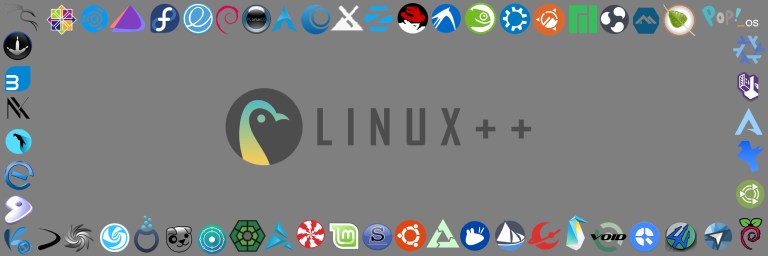
Hello and welcome to the twentieth (!) edition of Linux++, a weekly dive into the major topics, events, and headlines throughout the Linux world. This issue covers the time period starting Monday, June 1, 2020 and ending Saturday, June 20, 2020.
This is not meant to be a deep dive into the different topics, but more like a curated selection of what I find most interesting each week with links provided to delve into the material as much as your heart desires.
If you missed the last report, Issue 19 from May 31, 2020, you can find it here. You can also find all of the issues posted on the official Linux++ Twitter account here or follow the Linux++ publication on the Destination Linux Network’s Front Page Linux platform here.
In addition, there is a Telegram group dedicated to the readers and anyone else interested in discussion about the newest updates in the GNU/Linux world available to join here.
For those that would like to get in contact with me regarding news, interview opportunities, or just to say hello, you can send an email to linuxplusplus@protonmail.com. I would definitely love to chat!
NOTE: In a previous issue of Linux++, there was an article describing PINE64’s new PineTab model. I’m happy to announce that pre-orders have opened up for the device and can be placed here. Congrats PINE64 team on another wonderful device!
There is a lot to cover so let’s dive right in!
Personal News
Welcome to the Twentieth Edition of Linux++

Wow, twenty full issues of Linux++ have been released now! It seems absolutely crazy considering that I only began this publication at the beginning of the year, but here we are. I can’t thank everyone enough for the massive support and encouragement that has followed this work as well as the incredible people I have met along the way. The Linux community is certainly a wonderful place!
This month (June 2020) has proved to be one of the busiest months in recent memory, which has prevented me from releasing Linux++ on its regular schedule. From the many client projects being pushed back into the forefront (all at once) as our state opens up to preparing for our wedding later this month, spare time has been less than ideal right now.
Moreover, I was recently able to spend an entire week up at our cabin in northern Michigan at the beginning of the month, which was awesome and so refreshing, but also offered limited Internet connectivity (which actually wasn’t too bad!). In addition to all of this, I have recently returned to classes and they are full-swing now.
Knowing all of this, I realized that I wouldn’t be able to put out nearly as in depth of a product as I normally could if I attempted to keep to the weekly schedule. In response, I decided to pursue a kind of research project in order to bring an incredible story (that has impacted all of us in one way or another) to life in the publication’s “exploration” section that I think will benefit and intrigue everyone from the new users to even the most advanced superusers out there.
I wanted to take a peek back at the history of Linux as well as its forefather, Unix. This was in part inspired by an old book that I brought with me to our cabin entitled The Unix Programming Environment by Brian Kernighan and Rob Pike, two engineers at AT&T’s Bell Laboratories during the inception and creation of Unix by computer scientists Ken Thompson and Dennis Ritchie.
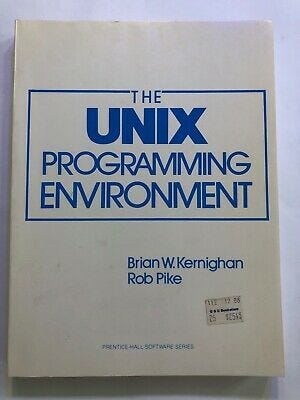
This happens to be the very first technical book that I ever read as a teenager after my discovery and consequent infatuation with the Linux operating system. While going through my dad’s book shelf, I stumbled across an old copy in his vast collection. From then on, I have had a technical book (or two or three) sitting on my nightstand at any given moment.
Though I had become comfortable with the “what” of Unix-based systems, I was much less versed in the “who”, “where”, “why”, and “how” of the story with only a condensed, overhead view of the history. Though there are many sides to what actually happened in those times, I have put a ton of research in and hope that you find the history as compelling as I have.

I want to thank each and every one of you for being so kind and supportive of this publication for the past six months. When I released the first edition of Linux++ back in late January, I had no idea what to expect. It’s safe to say that it has grown beyond my wildest imagination and that is due to all of the wonderful people who continue reading. So, THANK YOU! This is honestly my absolute favorite project and I feel lucky that I am able to spend time writing about something I love.
I hope that life will have settled down a bit as we move into July so that I will be able to return to the weekly schedule that Linux++ has employed since its inception and continue to provide in depth news in the usual style.
I hope you enjoy this special twentieth edition of Linux++, and, as always, long live GNU/Linux!
Community News
Linux Kernel 5.7 Released
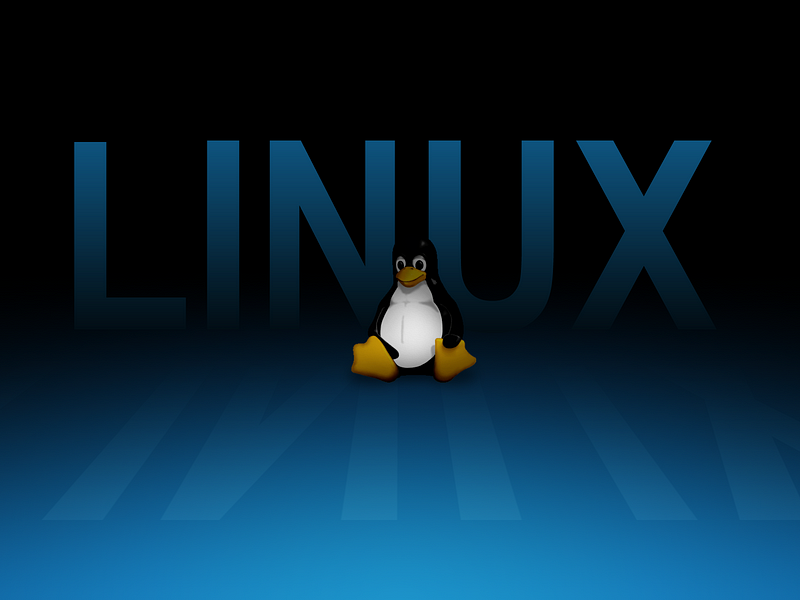
Well, it’s another month and with it another upgrade to the Linux kernel, this time version 5.7. This upgrade has a significant amount of updates, additions, and fixes included and is way too extensive for full coverage in this format. Therefore, I will try to sum up the features that I find to be most exciting in the latest release.
First and foremost, the most talked about feature of 5.7 is the addition of a new exFAT driver from Samsung. Previously, there was support for read and write operations added for exFAT by Microsoft in kernel version 5.4, however, that has been dropped in favor of this more efficient driver. exFAT is an extremely important filesystem from Microsoft as it is not only used in their own products, but many other devices as well.
Moreover, kernel 5.7 introduces native support for several PINE64 devices due to additional drivers for the RockChip RK3300 SoC and AllWinner A64 that function within the PineBook Pro, PinePhone, and PineTab. This is huge for the community-focused Linux hardware company and should allow them to iterate even faster on their design from here on out.
In addition, the task scheduler of the kernel now includes thermal pressure checking. This makes the task scheduler more aware of CPU frequency capping, which will undoubtedly lead to more efficient task placement in an overheated CPU. This will increase performance in that particular state significantly. All great news!
Another important feature involves adding detection for “split locks”, which can be quite pesky on the x86_64 architecture due to their occupation of the memory bus for approximately 1,000 CPU clock cycles. Therefore, the Linux kernel team have decided to implement a new detection feature in order to eliminate split lock operations wherever possible and send warnings to applications that utilize the process. The elimination of the split lock process should increase performance across all cores on a Linux system.
As with all major kernel updates, 5.7 introduces support for a range of hardware devices including Intel Tiger Lake and AMD Ryzen 400 “Renoir” graphics cards, Qualcomm Snapdragon 865, NXP i.MX8M Plus, Mediatek MT8516 SoC, and the Logitech G11 keyboard. Moreover, support for Apple’s USB Fast Charge was implemented into the mainline kernel as well.
This is quite a massive release and there are a ton more bug fixes, feature additions, and support added in version 5.7. However, it appears that Linus himself believes the next release, kernel version 5.8, may be one of the most important of all time. I guess time will tell, I’m just happy that the kernel team continues chugging along and bringing great features, bug fixes, and general improvements on a continuous basis!
If you would like a more friendly overview of the changes in the latest kernel release, you can find them here. It will likely take a while for 5.7 to drop into different distributions, however, if you want to try it out as quick as possible, Arch Linux will likely have it integrated in no time.
Lenovo’s Linux Legacy (Is Being Built!)
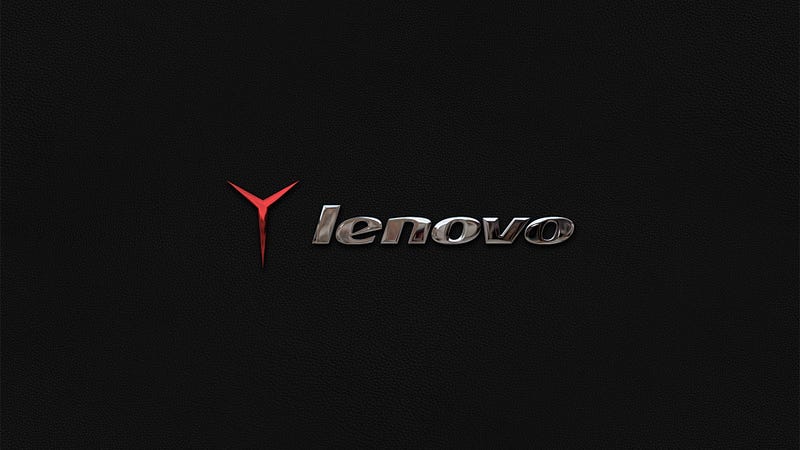
The past couple months have been a whirlwind when it comes to Lenovo’s commitment to native Linux support on their machines. Lenovo has always been highly revered in the Linux community due to the fact that their machines mostly just work with the open source operating system and are built with an immense amount of quality (and the best laptop keyboards out there!). Consequently, they have been a favorite for those running (or even developing for) Linux.
Recently, however, the hardware megalith announced a partnership with the Red Hat-sponsored, community-run Fedora distribution to take things a notch further with a plan to officially ship and support the system natively on a select number of laptops (Read more on this here). This was certainly a monumental announcement for Fedora and the Linux community as a whole due to the fact that Lenovo was respecting Fedora’s FOSS-only approach. However, this does mean that the potential models for Fedora will likely be limited since they do not include the proprietary NVIDIA blob drivers out-of-the-box and therefore would not be smart to ship with any system housing an NIVIDIA GPU (the vast majority of them).
Fret not Linux enthusiast, for Lenovo has recently announced another partnership that will allow Linux to ship natively on a much wider variety of devices — a partnership with Canonical, the developers of the most popular Linux distribution in existence, Ubuntu. Moreover, Lenovo has figured out a way around the NVIDIA problem for Red Hat ecosystem users — Red Hat’s official proprietary Red Hat Enterprise Linux (RHEL) 8!
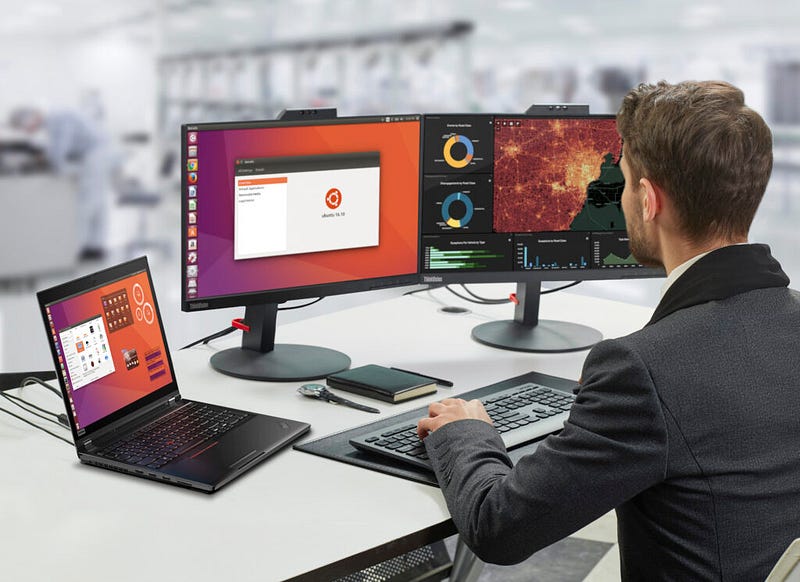
The devices that are currently being certified for both Ubuntu and RHEL include Lenovo’s entire ThinkStation desktop line as well as their ThinkPad P Series. That’s quite a few machines — and all will be available for purchase online with Linux pre-installed. Now, that’s what I call a win!
Though many in the Linux community are more familiar with the less expensive varieties of the ThinkPad line, this proves to be a huge first step for Linux support from a major OEM. At the moment, they are certainly targeting developers who require higher-tier systems, and from the looks of it, especially those in the artificial intelligence field. You can bet, however, that if these systems begin selling, they will put in the effort to make cheaper models available with the same perks. And that’s not all — in a recent press statement Lenovo commented:
“Going beyond the box, this also includes full web support, dedicated Linux forums, configuration guidance and more.”
So, in only a few weeks the Linux community has gone from minimal Linux support on Lenovo machines to having two of the biggest Linux-focused companies’ products available pre-installed, certified, and fully-supported on some really high quality computers. Incredible!
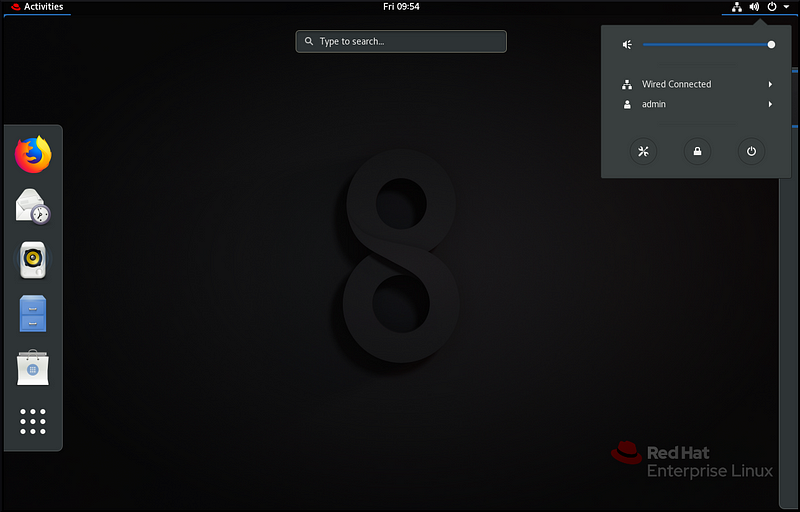
With this kind of dedication, support, and work going into Linux support, we can be assured that this is only the beginning. Though the ultimate goal is to see Linux exposure from the large retailers, we are still quite a ways away from running into “Focal Fossa” in the local Best Buy. Even so, it appears that someone has finally seen the impact that Linux has had on the desktop, even if it is miniscule (approximately 2.87 percent, or 7.2 million users, as estimated by NetMarketShare) compared to proprietary operating systems like Windows 10 or macOS.
With recent reports of a surge in Linux use over the past month, it certainly appears that people are starting to seek out alternatives to the proprietary standards of the industry. With Lenovo’s move into Linux certification and support, we could definitely see that market share creep up even more in the next year. Maybe even more OEM’s will follow suit. I’m not sure what the future holds, but I do know that this is without a doubt turning into one of the most exciting times in the (desktop) Linux world!
If you would like to check out the official announcement post by Lenovo, you can find it on their news blog here.
Linux Mint’s Controversial Announcement
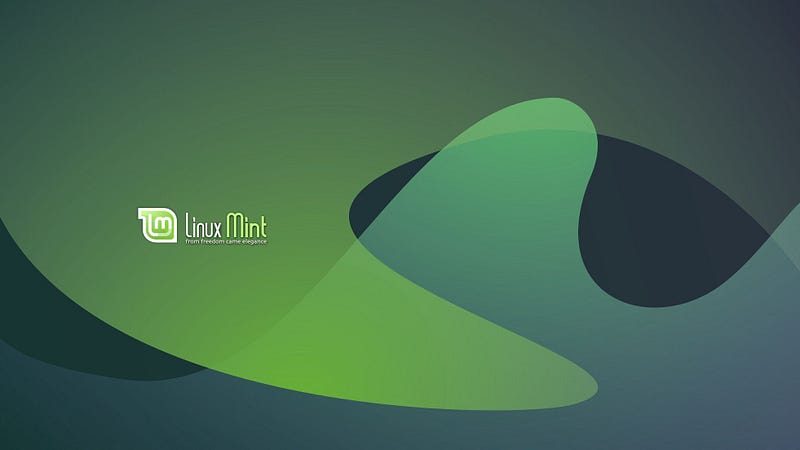
Linux Mint has been known for many things since their initial release in 2006, however, one major aspect of the project is that it marches to the beat of its own drum. Though Linux Mint may have been the first non-official flavour to base itself on Ubuntu, they have often carved their own path out and gone in very different directions than where Canonical took Ubuntu. In fact, one of the major reasons that Linux Mint was created was the differing opinions of what would become the Mint developers and the desktop team at Canonical.
Since then, and especially this decade, Linux Mint has truly blossomed into a completely different system than Ubuntu and other Ubuntu derivatives. Their GNOME Shell extensions became the base upon which their Cinnamon desktop was born, they included many extra Mint-specific tools not found in Ubuntu, and stuck very closely to the traditional desktop layout, which Ubuntu abandoned with the introduction of the Unity shell. Even under the hood, the Mint developers just do things quite differently.
So, what’s the latest “rebellious” news from the Mint team? Well, Snapd of course. The tool for installing Canonical’s Snap packages has been removed from the Mint’s APT repositories and is actually blocking the download from APT. In their monthly May 2020 blog post, Clément Lefèbvre (the founder and team lead of Mint), chose some pretty interesting words when detailing their controversial decision on Snapd. Though writing can obviously be taken out of context much easier than the spoken word, it is pretty clear exactly what Clem thinks of Canonical and the Snap project in the post. It is pretty hard to write off such strong language, even ignoring context.
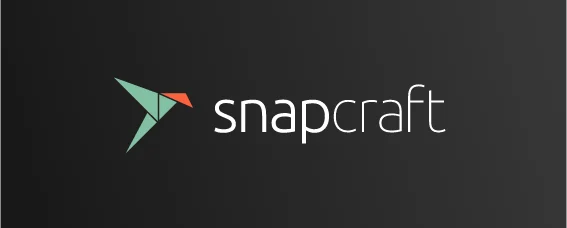
From Clem’s official statement of Snapd in Linux Mint 20:
“In the Ubuntu 20.04 package base, the Chromium package is indeed empty and acting, without your consent, as a backdoor by connecting your computer to the Ubuntu Store. Applications in this store cannot be patched, or pinned. You can’t audit them, hold them, modify them or even point snap to a different store. You’ve as much empowerment with this as if you were using proprietary software, i.e. none. This is in effect similar to a commercial proprietary solution, but with two major differences: it runs as root, and it installs itself without asking you.”
Therefore, Linux Mint will not ship with any Snap packages installed on the system or Snapd itself. In order to address the situation of missing packages like Chromium, Clem details what action they will take in version 20:
“
- In Linux Mint 20, Chromium won’t be an empty package which installs snapd behind your back. It will be an empty package which tells you why it’s empty and tells you where to look to get Chromium yourself.
- In Linux Mint 20, APT will forbid snapd from getting installed.”
Of course, as with any situation, there are valid points that are made on both sides. It is true that Snapd installed on the system by default will connect to Canonical’s proprietary Snap Store, however, calling that a “backdoor” is a bit over the top in my opinion. Of course, the Mint team has every right to structure their distribution as they see fit, however, many think that this change is ultimately against Linux Mint’s ideology of providing freedom to the user, especially as a new user-focused distribution.
By disallowing a user to install Snapd through APT could potentially restrict users from downloading software that is only available in the Snap Store. In addition, Snap is by far the easiest of the universal packaging formats including Flatpak and AppImage. For a new Linux user, getting Flatpak to work properly takes quite a bit of extra work and requires knowledge of Flathub as well as the particular package’s name and identification within the decentralized repository. On the other hand, since Snaps only have a single centralized repository, it is much more natural for new users to learn how to install Snap packages as it resembles the APT system much more naturally.
There are plenty of other arguments going on around this decision by the Mint team, however, I will not indulge them in this piece as I don’t want to start a flame war or anything. A quick search on the Internet will give you plenty of results being discussed in open forums like Reddit.
I will say one thing though — with all of this rebellion against Canonical and Ubuntu, it sure does seem a bit weird that Linux Mint is willing to take advantage of all their hard work without a peep. Simply, Linux Mint would not be able to exist as it is without using Ubuntu or Debian as a base — they just don’t have the developer and maintainer power to keep their own repositories of that magnitude.
Moreover, System76 approached the same dilemma with a much more level-headed assessment and solution (in my opinion) with their Pop!_OS distribution. Instead of banning Snapd altogether, the Pop developers decided to include the Chromium package within their own repositories and not have Snapd installed by default. However, they in no way blocked Snaps from being accessed or used at all. Snapd can still be installed with a single command on Pop!_OS as per usual: sudo apt install snapd. It seems like Mint could have taken a similar approach if they wished.
So, I have to question if this might become the last straw for the Mint developers, where they finally decide to drop their Ubuntu-based distribution and pick up Linux Mint Debian Edition (LMDE) as their only offering. I mean, it seems that if you hold such a grudge against the company and developers who literally provide you with ninety percent of your operating system that you would start looking for alternatives — and hey, you already have one with LMDE!
I’m certainly excited to see what comes with Linux Mint 20, even with the controversy, as it is undeniable that the Mint developers have created and fostered a truly incredible distribution. As developers, they are allowed to have their own opinion on the ecosystem and if users don’t align with that, there are plenty of other choices out there.
If you would like to read the official statement detailing Mint’s decision on Snaps, you can find it in their Montly News blog post for May 2020 here. In addition, if you would like to give the beta release of Linux Mint 20 a try, you can download it from here.
elementary OS Hera 5.1.5 Out Now!
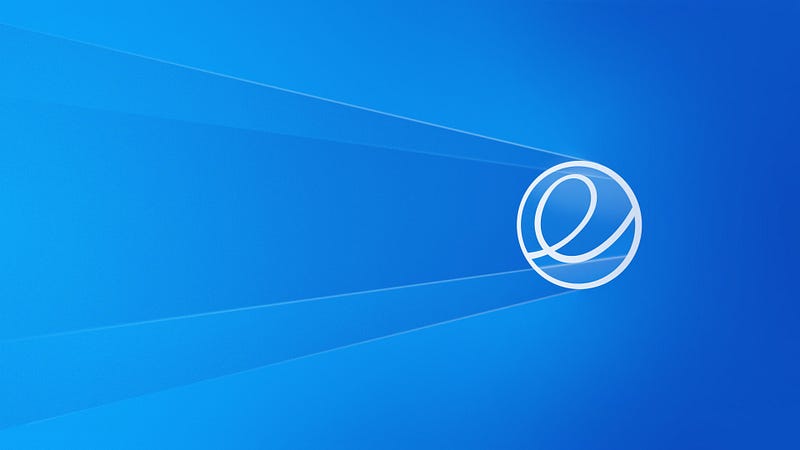
When talking about prominent Linux distributions in today’s world, there is no doubt that elementary OS deserves a seat at the table. The eye-catching and productive Linux distribution does many things well — keeping a coherent and consistent feel across its application ecosystem, a simple to use and intuitive design, and it gets out of your way so you can focus on what you’re working on. The homegrown Pantheon desktop environment is absolutely gorgeous as well, with elements of GNOME 3, macOS, and elementary’s own uniqueness that combine to make an absolutely incredible user experience.
Therefore, it’s no wonder that elementary OS has seen quite a massive uptick in users over the past few years. When the distribution released it’s heavily anticipated version 5.0, codenamed “Hera”, in October 2018, it was met with high praise all around the Linux world.
This week, the wonderful folks behind elementary OS have announced the release of the next iteration in the “Hera” line, elementary OS version 5.1.5. With this new point release, comes quite a few “quality-of-life” improvements that I think elementary OS users everywhere will highly appreciate.
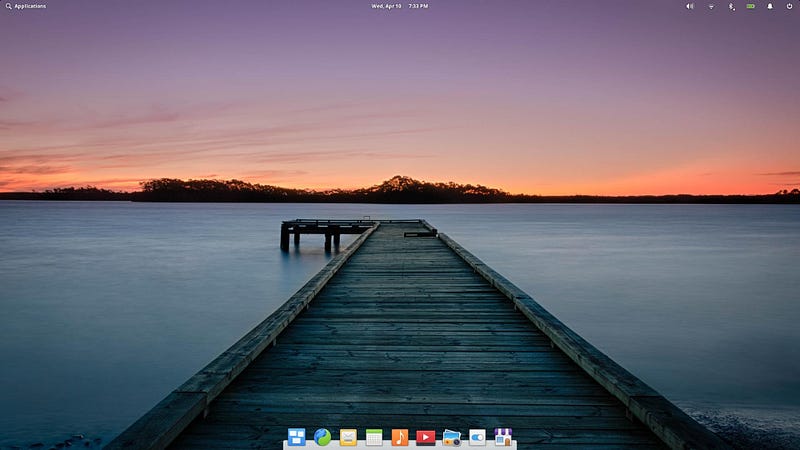
The main focus of this release is elementary OS’s own software center, known as AppCenter. Though AppCenter was originally designed for developers to create applications specifically for elementary OS and its style guidelines, there has been a recent movement, known as “AppCenter for Everyone”, to bring these applications to other Linux distributions through integration with Flatpak (more information on AppCenter For Everyone can be found in Linux++ from February 9, 2020 and March 29, 2020).
In elementary 5.1.5, the developers made a huge decision regarding the AppCenter — namely, that users can now install updates to their system without root privileges. From the official elementary OS update blog:
“Since an administrator had to approve the original installation and we provide clear expectations around curated versus non-curated apps, it didn’t make sense to make users authenticate just for updates. This is part of our ongoing work on reducing authentication fatigue and only elevating permissions when necessary.”
This may be a controversial opinion by some in the Linux community, especially those concerned with security and privacy, however, it is totally understandable and should make life easier for those on elementary OS. Moreover, the elementary OS developers pointed to the fact that Flatpak applications (that are installed by default on the system) do not require authentication either.
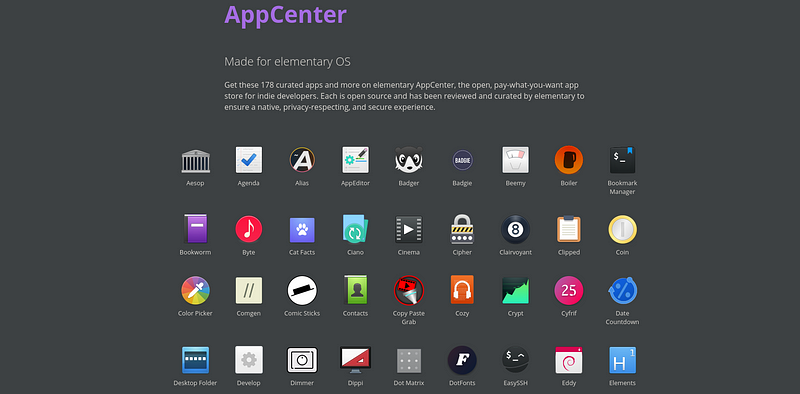
As far as other aspects of the AppCenter are concerned, improvements were made to the display of applications on the homepage by using a caching system to hold on to previous results in order to fall back on them if required. In addition, the elementary OS developers improved the Dock badge number so that it accurately reflects the current number of available updates to the system.
Moreover, elementary OS 5.1.5 ships with some updates to their homegrown file manager, File Manager. One massive improvement concerns the pasting of image files from the File Manager. Now, users are able to copy the actual image itself (instead of its file path on the system) inside of the File Manager and paste it right into other applications, like an image editor or even some web applications in supported browsers. In addition, users are now able to paste one or more cut or copied files into a different folder by using the copy command, Ctrl + V, with the output folder selected.
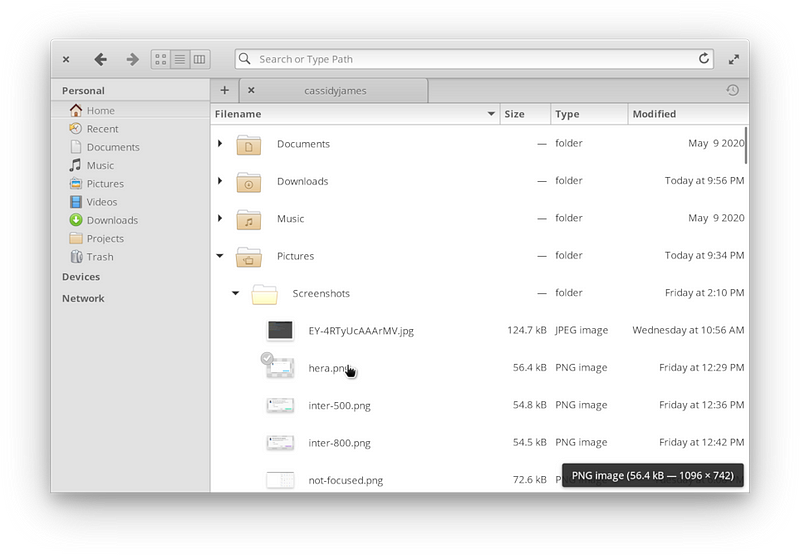
Moreover, the file overlay now shows file info in list view as well in order to make it much faster to see the size of files and images. The Tab key can be utilized to cycle through search results instead of only using the arrow keys. Also, there is a new dialog prompt implemented for when users attempt to open files in the trash. This dialog reminds users that they must either restore or move the file out of the trash before opening it.
There are quite a few more “paper cut” fixes with elementary OS 5.1.5 including improved support for various network encryption models as well as a more accurate description of the encryption type in the Network Settings menu, the fix of a freeze when changing settings from multiple different panes like Power, Date & Time, and Desktop settings, improved performance while switching months in the Date & Time indicator, a fix of missing event dots in certain occurrences, and a fix of several issues with adding and removing monthly recurring events in the Calendar app itself.
Though many are awaiting the highly-anticipated release of elementary OS 6.0 since the release of Ubuntu 20.04 LTS as base system, it is good to see the elementary developers continuing to work on and improve “Hera”. I want to give sincere congratulations to the elementary OS team for continuing to put out one of the most polished and easiest to use Linux distributions in existence. Keep up the great work!
If you would like to read the official release notes from Cassidy Blaede James of the elementary OS team, you can find them here. In addition, if you would like to keep up-to-date with the elementary OS project, you can follow them on Twitter, Facebook, Slack, Mastodon, Reddit, and their official news blog. If you would like to give elementary OS 5.1.5 a spin for yourself, the link to download the ISO image can be found at the top of their official homepage here.
KDE’s Plasma Desktop 5.19 Officially Released

After nearly four months of work, KDE has announced the release of the newest major version of its Plasma desktop environment, version 5.19. For quite a while, Plasma has been the go to desktop environment for customization and ease of configuration. Unlike the other full-featured desktop environments available on Linux, Plasma has an option for literally every piece of the desktop — and won’t make you mess with configuration files because its all available through the GUI itself! For this very reason, many Linux distributions ship with Plasma as their default desktop environment, or at least a choice at the time of install.
With their successful release of Plasma 5.18 LTS earlier this year, many in the Linux community were wondering where the Plasma developers would head next. Well, it appears that this release is all about the polish, baby!
As if Plasma wasn’t a gorgeous enough desktop before, the team at KDE have been working tirelessly to improve the look, feel, and continuity of the desktop — making it a top priority in this release and coming through in spades.
The first upgrade comes with the new Flow wallpaper designed by Sandra Smukaste specifically for Plasma 5.19. In order to improve personalization of the desktop, the Plasma developers also added quite a few new photographic avatars that can be utilized by new users on the system.

As far as continuity in the desktop department, the Plasma developers have worked on quite a few smaller graphical fixes with 5.19. One obvious change is that of a consistent design for the header areas on all of the system tray elements. In addition, the panel spacer widget has been alter to allow users to automatically center widgets, which is an awesome touch. The Plasma developers have also decided to increase the fixed-width font size from 9 to 10 to make text more readable throughout the desktop.
Moreover, the incredible work on GTK compatibility that came with version 5.18 continues on with the latest release. With 5.19, GTK 3 applications will now immediately respect and apply any newly selected color scheme or theme. In addition, the broken colors in some GTK 2 applications have been fixed, giving the system a much more consistent look across all UI elements.
It also appears that some work on updating the design of certain widgets has been done in 5.19. These include the media playback option of the system tray, the task manager tooltips, system monitor widgets — which were all rewritten from scratch — and the sticky notes widget, which got several usability updates.
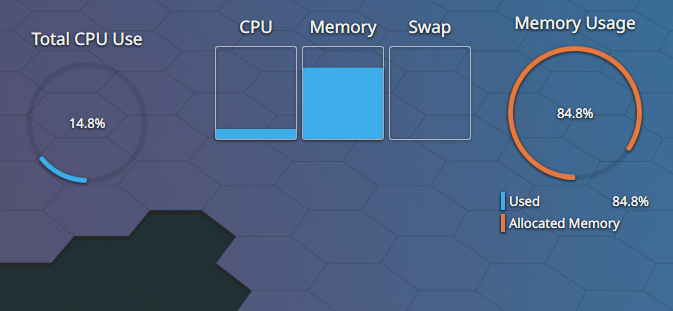
One major area of the desktop that was focused on in 5.19 is the system settings menu. Improvements to the file indexing process bring with it the ability to configure an assortment of indexing options for directories on the system, which can also ignore hidden files if needed. For the look and feel of the system settings windows, the KDE developers have redesigned many of the menus with small improvements to the font configuration and more. Some of the most heavily impacted menus include Default Applications, Online Accounts, Global Shortcuts, KWin Rules, and Background Services. Moreover, the Info Center has been redesigned to mirror the aesthetics of other system settings modules, giving a much more consistent look throughout the system.
In addition, work on KRunner, a simple to use global search tool for launching applications, directories, and files has been improved so that users will be sent to the correct system settings menu page requested from within the program instead of to the main system settings page.
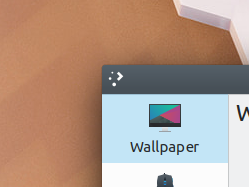
The default window manager that ships with KDE’s Plasma, KWin, has also seen some new features drop into 5.19. The major improvement here is the inclusion of subsurface clipping, which can help greatly reduce any flickering of applications and, consequently, reduce eye strain. Also, the application titlebars have been recolored in order to fit the system color theme, which makes them easier to read altogether. For bonus points, the KDE developers threw some love to Wayland, which now supports screen rotation for tablets and convertible laptops.
In addition, KDE’s homegrown application store, Discover, now includes functionality for removing Flatpak repositories in a much easier manner. On a similar note, Discover now displays the the application’s version in 5.19. Due to the ability to have several different versions of the same software on a single system with the universal packaging formats like Flatpak and Snaps, this improvement can be quite useful when searching for the corresponding application in Discover.
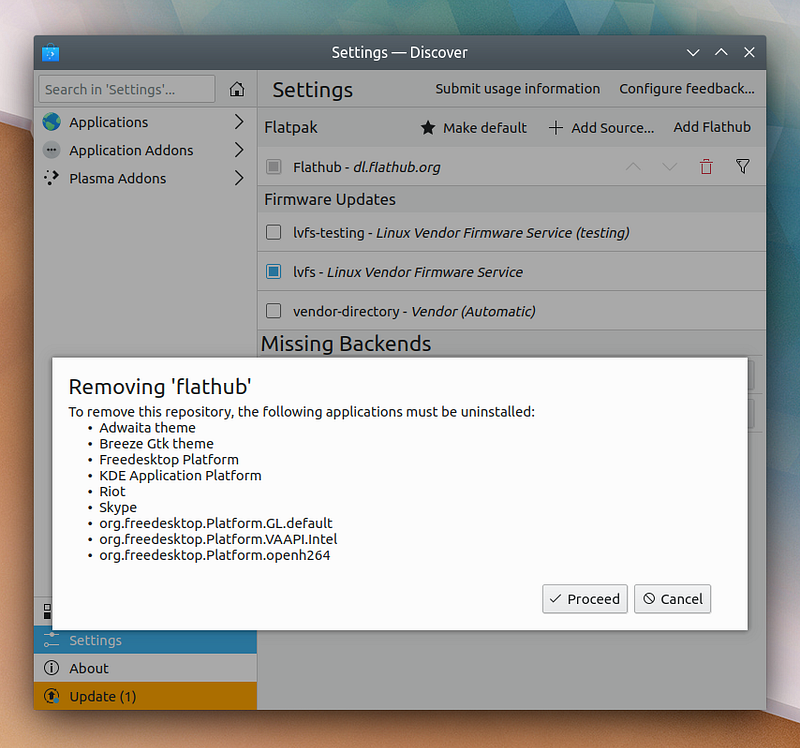
I want to take a moment to congratulate the awesome developers over at KDE for continuing to put out massive improvements and changes with each release. The work on continuity is extensive and gives an incredibly more professional air to the desktop environment. Keep up the awesome work!
Along with all of these details, there are quite a few more smaller (or “papercut”) improvements provided by the Plasma developers, so I highly suggest you check out the official release notes, which includes a link to the full changelog, here. If you would like to try out Plasma 5.19, you can likely find it in rolling release distributions like Arch Linux or Manjaro, as well as KDE’s own Ubuntu-based KDE neon distribution.
MX Linux 19.2 Available for Download

MX Linux has undoubtedly become one of the fastest growing distributions in recent memory. Compared to a few years ago, it is now one of the hottest topics of discussion in the Linux community. With its unique and innovative MX Tools, familiar layout, and now the Advanced Hardware Support (AHS) edition, MX has proven time and time again that it deserves its own slice in the spotlight.
MX Linux is based on the popular Debian distribution, however, it allows for quite a few advancements over its parent. For this reason, MX Linux has become popularized not only for new users, but also veterans in the Debian ecosystem and beyond. Though many attribute it as an awesome distribution for older hardware, the AHS version now allows MX Linux to take advantage of users with newer hardware stacks, increasing its sphere of influence quite a bit.
In addition, MX Linux is well-known for its transparency within the Linux community and the original creator, Dolphin Oracle, can be found hanging out in many highly popular Linux community areas. Due to his impressive involvement with users, MX Linux has cultivated an extremely passionate, friendly, and compassionate community surrounding the distribution and the philosophy behind MX itself.
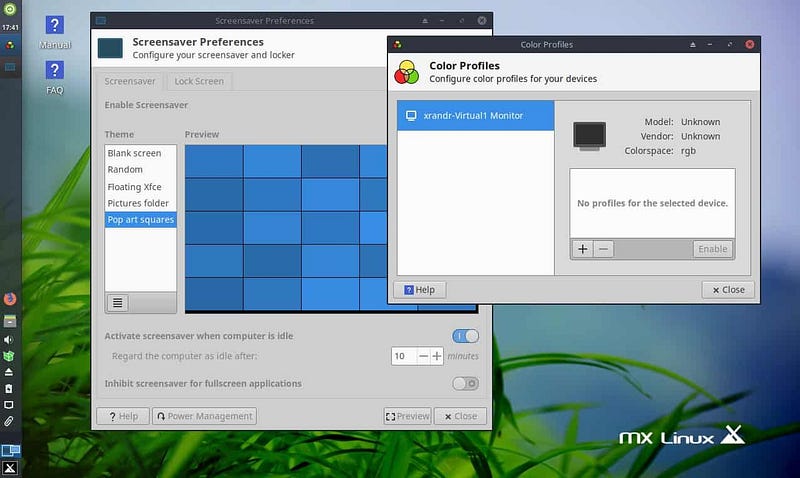
This week, the MX Linux developers announced the release of their second refresh of the highly-touted MX Linux 19 series. Version 19.2 comes with all the updates that dropped into Debian “Buster” 10.4 including kernel version 4.19 as well as an updated kernel version 5.6, Mesa 20, and an updated firmware package with the AHS ISO image. Contrary to past system upgrades, MX now supports an auto-updated kernel along with all of the Debian sources by default, which is awesome!
Along with the low-level system upgrades, popular applications and tools have been updated from the Debian 10.4 stable repository including Xfce 4.14, GIMP 2.10.12, Mesa 18.3.6, Firefox 76, VLC Media Player 3.0.10, Clementine 1.3.1, Thunderbird 68.6.1, LibreOffice 6.1.5, and more in MX Linux’s own repository.
Some of the MX applications that have received significant attention in the new release include mx-installer, mx-packageinstaller, and conky-manager. In addition, the recently added Fluxbox version of MX, known appropriately has MX Fluxbox, has seen some significant updates including localized default menus, an updated artwork package, a new vertical launcher bar, updated documentation, and a new MX Tool to manage the idesk settings. Also, many of the MX applications have received multiple translation updates from MX Linux 19.1.
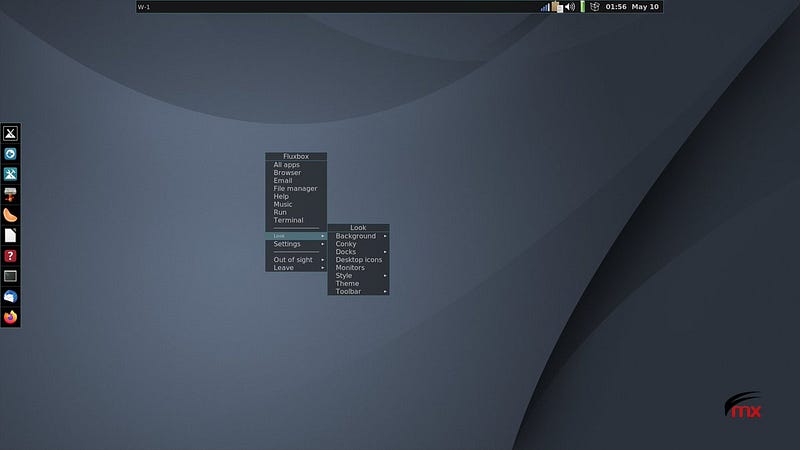
This is definitely some significant work for the new point release that should heavily improve the functionality and quality-of-life of MX users everywhere. I want to give my sincere congratulations to Dolphin Oracle, the entire MX development team, and anyone who helped to make this release come to fruition. Keep up the awesome and innovative work!
If you would like to read the offcial MX Linux 19.2 release notes by Dolphin Oracle, you can find them here. In addition, if you would like to keep up-to-date with everything going on in the MX Linux world, you can follow them on their official Twitter, Facebook, Mastodon, Reddit, and YouTube. If you would like to give MX Linux 19.2 a spin for yourself, you can find the direct download and torrent links for the different ISO images here.
FreeNAS 11.3: What’s New

When it comes to highly scalable network-attached storage operating systems in the open source ecosystem, there is none greater than the highly-popular FreeNAS. Created by Oliver Cochard-Labbé in October 2005 (and later transferred to iXsystems), FreeNAS is based upon the most popular BSD (Berkeley Software Distribution) in existence, FreeBSD. FreeNAS is compatible with Linux, BSD, Windows, and macOS clients, making its reach even further spread. It utilizes the awesome power of the OpenZFS file system, which includes some major advantages and key features over other popular file systems you might encounter in the Unix-based ecosystem like ext4, XFS, or Btrfs.
The ZFS file system structure has seen an increasing rise in awareness throughout the Linux ecosystem, especially with major distributions like Ubuntu attempting to integrate it into their software stack. However, users of BSDs are no stranger to the ZFS filesystem, as it has been in use in their ecosystem for quite a while now.
This week, iXsystems announced the release of FreeNAS 11.3, which comes with significant improvements and alterations that have occurred over the the past year. Besides the usual ZFS performance optimizations that come with each new release of FreeNAS, there is quite a bit of new functionality and bug fixes that iXsystems have baked into 11.3.
One of the most important contributions is a rewrite of the Replication Engine. This optimization will allow for up to 10GB replication speeds (a 10% performance improvement!), support for resuming failed transfers, and the ability to replicate locally. In addition, a new ACL Manager provides functionality for the setup and management of SMB ACL’s (access control lists), which is integrated into the FreeNAS web interface.
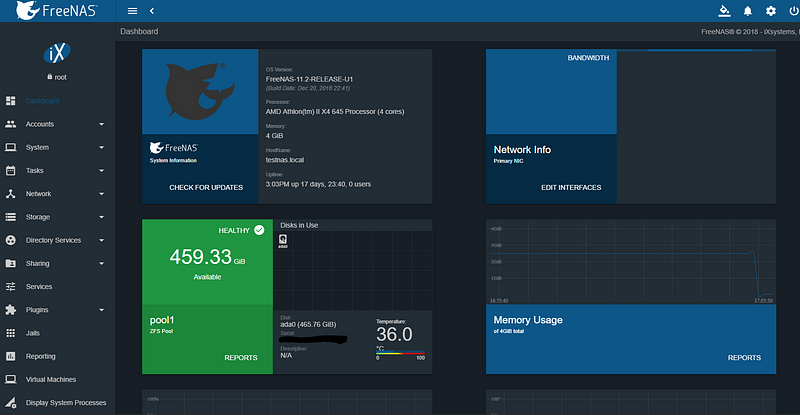
Moreover, SMB Shadow Copies are enabled by default for new shares, a repository of Community Plugins has been setup for the creation and distribution of 3rd party plugins that are not officially supported by iXsystems, and an iSCSI Wizard has been implemented to smooth out the process of creating a new iSCSI target with only a few clicks!
As far as functionality is concerned, iXsystems has overhauled the alert/notification system for FreeNAS allowing for more granular control over configuring the alert thresholds. Also, the dashboard has been upgraded heavily to include a live snapshot of the system status, which includes network traffic, CPU and memory utilization, and quite a bit more. iXsystems also integrated NAT support for plugins, which should remove the need for each plugin to have a distinct IP address on the network.
Another major enhancement with 11.3 is the full-featured 2.0 API. This integrates both REST and Websocket connections, which allows the system to be fully automated via the same API that the web interface utilizes. Moreover, a new ZFS tool, Large Pool Creation Assitance, allows an automated way to repeat virtual device (VDEV) layout across all remaining disks through the UI when creating pools with a very large number of disks.
This is an exciting release and I’d like to congratulate iXsystems on pushing the boundaries of FreeNAS even more. It truly is the world’s best open source storage operating system and as long as releases like this keep rolling out, I don’t see that changing any time soon!
If you would like to check out the official release notes for FreeNAS 11.3 from iXsystems, you can find them here. In addition, if you would like to follow along with FreeNAS development, you can find them on Twitter, Facebook, and YouTube, as well as their official news blog. You can also find the latest ISO image for FreeNAS 11.3 here.
Community Voice: Cassidy James Blaede

This week Linux++ is very excited to welcome Cassidy James Blaede, co-founder of elementary OS, tech blogger, active Linux community member, and open source UX architect. Cassidy is well-known for his writing and crafting of great blog posts as well as elementary OS update posts. His team at elementary OS have gone on to create one of the most popular distributions in the Linux world right now and continue to push the boundaries of what is possible. So, without further ado, I’m happy to present my interview with Cassidy:
How would you describe Linux to someone who is unfamiliar with it, but interested?
“Linux is a core piece of an operating system — it’s what’s under the hood of things like Chrome OS and Android. But, there are all sorts of operating systems built on top of this Linux core, like elementary OS. What’s cool is that Linux and these operating systems are open source, meaning the code is freely available for anyone to look at and modify for their own purposes. Plus, most of these Linux-based operating systems work together behind the scenes to make all of the technology they rely on better; I like to call it ‘coopertition’.”
What got you hooked on the Linux operating system and why do you continue to use it?
“Throughout my childhood, I got hand-me-down desktop computers from my siblings, who got them as hand-me-downs from my parents. So, I was always several generations behind modern computing. These computers ran DOS or Windows 3.1.1 or Windows 95 or whatever was a few releases behind at the time. I always loved tinkering within and learning those environments, but eventually my tinkering and tweaking would wreck the OS and necessitate a reinstall. Eventually, I found out about Linux live CDs — Knoppix at the time, and then Ubuntu — that would let me run an entire operating system without messing up the original OS at all. I was hooked. At some point, I ended up installing it full-time, and I’ve never looked back.
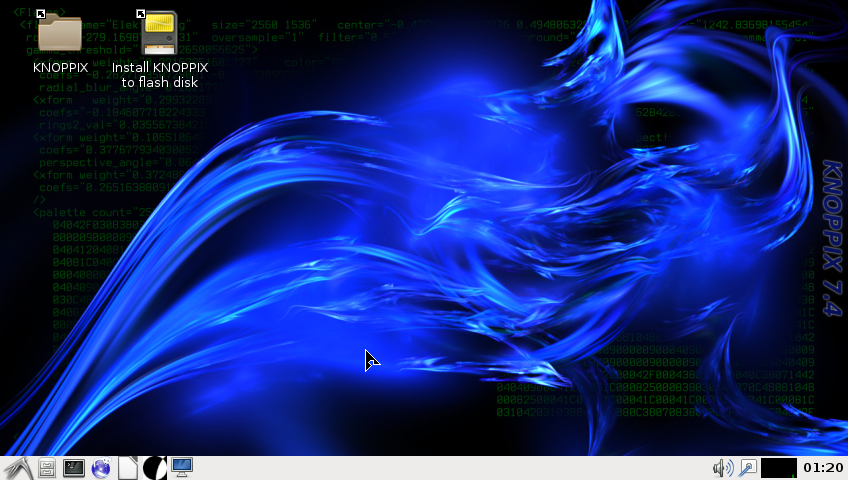
After that, I was in love with customizing icons, wobbly Compiz window effects, and the works. But, eventually I found this small project called ‘elementary’ that was building out a a well-designed suite of icons and apps for Linux. I got involved and soon after, we released the first version of elementary OS.
I use elementary OS because I believe dogfooding is critical to the experience of building a product — if you don’t use your product, how do you know what your users are experiencing every day? More fundamentally, I use elementary OS because I believe it’s the best user experience on a computer and because I value my privacy.”
What do you like to use Linux for? (Gaming, Development, Casual Use, Tinkering/Testing, etc.)
“I use it for pretty much everything! I run elementary OS on my laptops — an old System76 Galago UltraPro with the stable release and my main development Dell Precision with the bleeding edge. I use my main laptop for everything from web and desktop development to writing and Interneting. I also have a System76 Meerkat mini PC attached to my TV for light-weight gaming, group video calls, and some media consumption.

I’ll admit, I do have an Android phone and use it for most of my social media and actually light-weight photo editing these days. And, I have a few game consoles for more high-end gaming — I’ve never been a fan of bulky tower PCs, and consoles are zero-maintenance, which I appreciate.”
Do you have any preference towards desktop environments and distributions? Do you stick with one or try out multiple different kinds?
“I’m a bit biased, but of course I prefer Pantheon on elementary OS. I love that it’s a nice mix of a very modern feeling experience while sticking to tried and true desktop conventions. It gets out of my way and lets me do my work (or play!).
To be fair, I also really appreciate what GNOME has been up to over the past several years. They’ve been putting a ton of great design and engineering work into the desktop, and that’s apparent with improvements to Mutter, GTK, and more. We’re lucky enough to be able to benefit from some of those improvements in elementary OS since we build off the same technologies, even though we’re not actually using GNOME Shell or the GNOME desktop.”

What is your absolute favorite aspect about being part of the Linux and open source community?
“I love the coopertition. We’re all working together, and yet we have different visions for what the best product is — and that’s healthy! We’re able to focus on improving shared technologies and cross-desktop initiatives, which makes the Linux desktop as a whole more robust and diverse.”
What is one FOSS project that you would like to bring to the attention of the community?
“Most everyone in our community is aware of Flatpak, but I’m excited to see the infrastructure side around remotes like Flathub and AppCenter become it’s own thing; it should be easy for anyone to spin up a Flatpak store, but right now there are several pieces of infrastructure that you have to get all working together, and hardly anyone does it. So, I’m excited to see those infrastructure projects working together and lowering the barrier for Flatpak remotes.
Do you think that the Linux ecosystem is too fragmented? Is fragmentation a good or bad thing in your view?
“Ha, I addressed this earlier, but I’ll reiterate it here. The diversity of visions and technologies in the Linux world is healthy — and essential. As long as we’re working together as much as we can while understanding our differences, it’s good for the future of our projects individually and for Linux as a whole. The holy-war-esque fighting between technologies does need to stop, and all the negativity needs to go away.
And, sometimes, a project might need to make the hard decision to redirect resources towards a more de-facto technology (see: upstart/systemd, Unity/GNOME Shell, etc.). But, the existence of those ‘competing’ projects in the beginning was absolutely a good thing, and the coopertition helped drive all of our technologies forward.”
What do you think the future of Linux holds?
“I’m no savant, but I believe more and more people will become fed up with the status quo of computing — whether that’s the rampant privacy invasions, dumbled-down mobile devices, or poor design on the desktop — and seek out alternatives. Linux-based operating systems like elementary OS are ripe for the uptake, and it’s what we’re already seeing today. I believe this will continue to escalate in the coming years.
Longer-term, I’m less sure. I could see Microsoft moving to a more Linux-centric OS over time as a proprietary desktop OS becomes less and less important to their bottom line. I think we’ll still have at least a handful of different projects with different visions, but I think different hardware platforms will also play into what projects decide to focus on: do we expect to see Ubuntu on AR glasses and watches in addition to workstations and servers? I kind of doubt it; maybe under-the-hood, but I don’t know that any one Linux-based company will really be designing for all of these different form factors and their unique user interactions.
My hope is that long-term, we retain the friendly cross-project coopertition that we’ve always had, and that projects like FreeDesktop.org keep up with the changing landscape. No single company or OS needs to design for all the different form factors if we ensure they’re standards-based and technically interoperable as much as possible.”
What is your absolute favorite part about working on elementary OS?
“The self-employment is nice! Honestly, being able to bounce between so many diverse tasks and disciplines is a perfect fit for me, and is a huge part of what I love day-to-day. I also love working with so many talented people within the open source world, and knowing that we’re all working together to build better products.”
Are there any elementary OS-specific features that you think sets it apart from other distributions? Is there a particular “target audience” that elementary OS is trying to reach?
“AppCenter is definitely the killer feature of elementary OS. We’ve built this great app store with tons of apps designed for the platform where users can easily and directly support the developers. Apps are updated frequently, developers get paid, and there’s a unique sense of community around the whole thing. It’s unlike anything you see on any other platform.
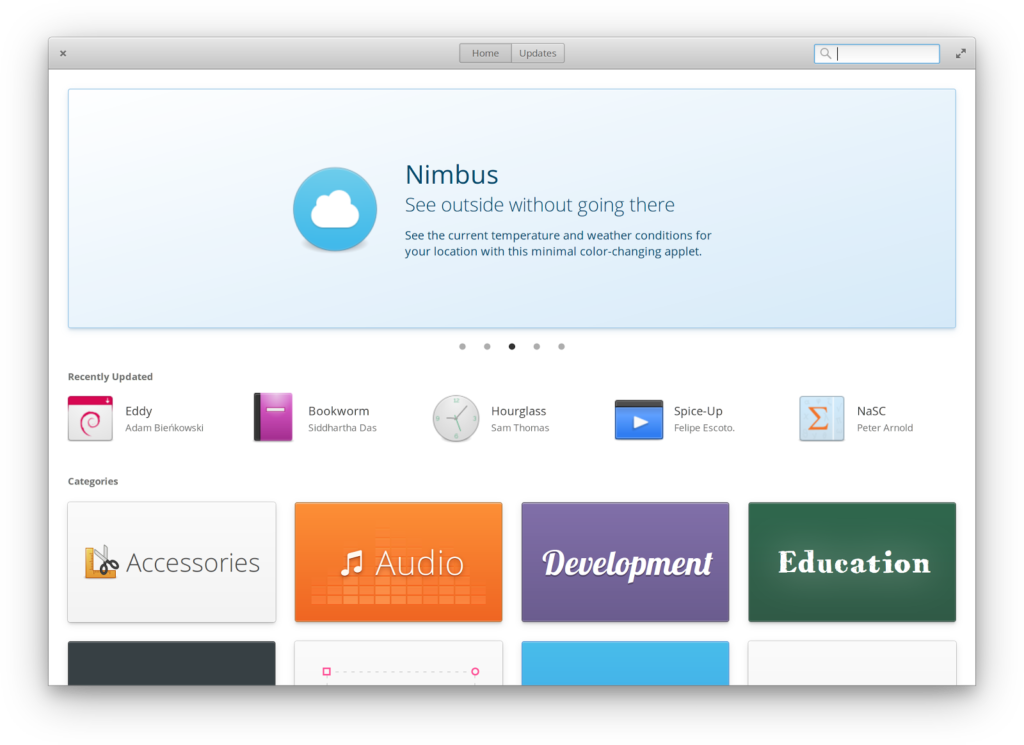
And it sounds weird to have as a feature, but elementary OS has always been fanatical about the user experience — we’re opinionated, but it means you spend less time fiddling with things, and more time actually doing things in elementary OS. Whether that’s writing, developing, running a business, doing schoolwork, or playing games.
elementary OS is designed to be a replacement for whatever OS you’re using today — whether that’s macOS, Windows, Chrome OS, or mobile OSes — so we don’t have a small target audience. But, we’ve found a lot of success with a few groups in particular: developers, no-nonsense computer users, and what I call the family IT person.
Developers are an obvious fit for any Linux-based OS, but elementary OS in particular gets out of your way and lets you focus on building and maintaining your web service or app. Plus, since we use elementary OS to build elementary OS, we’ve focused on building in killer developer tools: like the smart Terminal with natural copy/paste, browser-class tabs, and one-click accessible color schemes; or Code, our editor with built-in Git support and smart defaults; or the Files app with checkerboard cards behind transparent images, miller columns, and again, built-in Git support.
No-nonsense computer users may sound like a weird category, but it’s inclusive to students, press, and others who just want a no-fuss machine to get things done.
And, the ‘family IT person’ might be the parent who sets up a machine for their kid — or increasingly, the kid who sets up a machine for their parent. They choose elementary OS for its ease of use and no-nonsense design. And, oftentimes, its Linux underpinnings are attractive in case they need to customize or automate anything for specific use cases.”
How did your adventure into developing for Linux come about?
“Once I was using Linux, I pretty quickly wanted to start making things better. Luckily, I found the elementary project, and started helping by writing blog posts, recording tutorial videos, etc. The core team invited me to join in a more official capacity, and I’ve been at it ever since. I actually didn’t really touch code for elementary OS until a few years ago, when we started writing our developer guide for third-party app developers. I walked through that to make sure it was a good intro to developing on elementary OS, and apparently it worked — I’ve since developed half a dozen of my own apps, prototyped major desktop features, and contributed to almost all of our hundred-plus code repositories.”
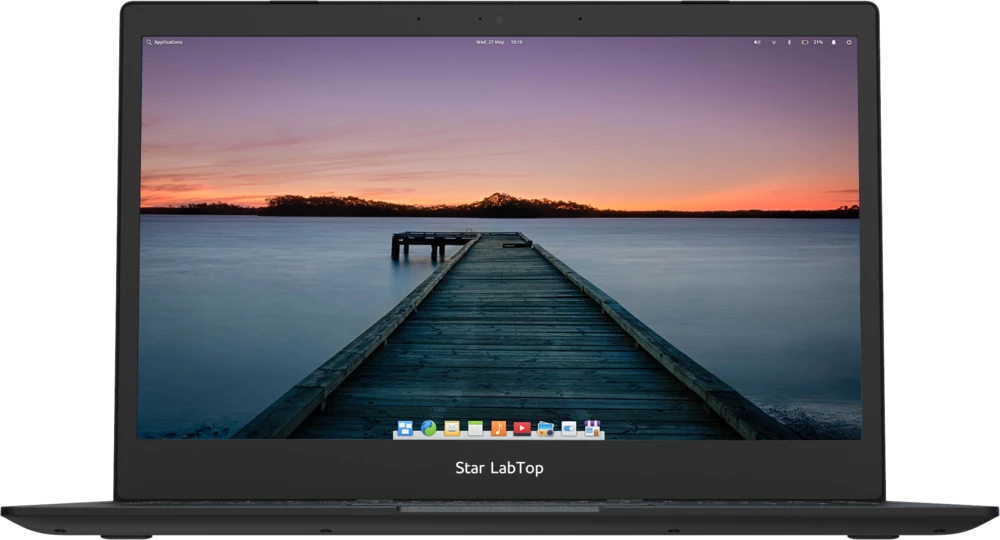
What has helping run the elementary OS project been like? Any rough bumps in the road as well as periods of absolute enjoyment?
“Honestly, it’s been awesome the entire time. Some times have been less certain than others, of course; for example, quitting my awesome job at System76 to jump into elementary full-time was pretty scary, but it has worked out extremely well. And, at times it can be discouraging when people — beit trolls or just frustrated users — resort to unnecessarily harsh words and personal attacks. But, for the most part, I keep trucking on and remind myself of the of the hundreds of thousands of folks out there quietly using and enjoying elementary OS.
The most fun I have definitely comes from in-person meetups, whether small elementary sprints or larger events like GUADEC. There’s just so much more energy and communication bandwidth when you’re in person, and it ends up being both incredibly productive and loads of fun.”
Is there anything exciting planned for the future of elementary OS, without giving too much away?
“elementary OS 6 is still in the pretty early stages, but it’s at least usable enough for me day-to-day now without major breakage. And, there is a lot of work going into both its design and customizability that excites me. I’ve also been spending a lot of time talking with smaller OEMs, and we’re starting to see the fruits of that labor with increasing options for getting a machine with elementary OS out-of-the-box.”
Do you have any major goals that you would love to achieve in the near future?
“The big one is getting AppCenter completely moved over to Flatpak, which will improve the experience for developers, the security and privacy for users, and the review process for elementary. We were planning a sprint, but had to delay it due to COVID-19; I’m excited to be able to get in person and knock that work out as soon as it’s safe for us to do so.”
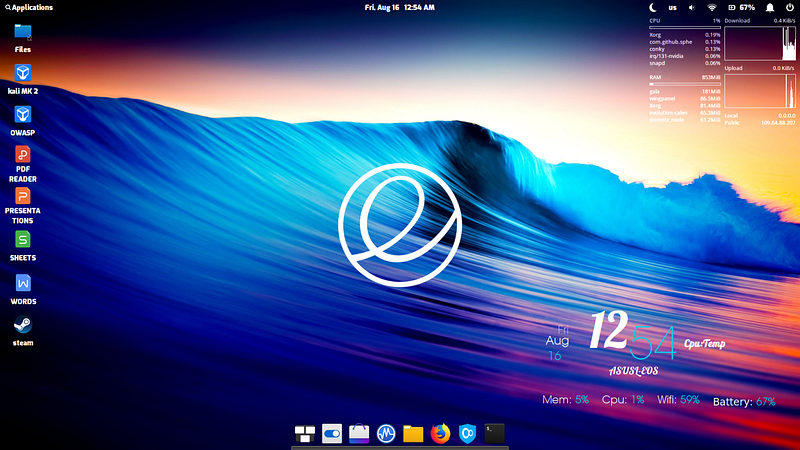
I just want to wholeheartedly say thank you to Cassidy for taking time out of his extremely busy schedule to prepare an interview for Linux++! If you would like to keep up with the latest news from Cassidy and the elementary OS team, you can follow along on Twitter, Facebook, Telegram, Reddit, Stack Exchange, Slack, Mastodon or check out the official website here.
Exploring Linux History
For the special twentieth edition of Linux++, we are going to take a trip back in time to see where the seed of Linux was planted — namely via the Unix systems of the early 1970s and how it has progressed through the modern day. Though most are completely unaware of the enormous impact that Unix-like operating systems have planted on our society, understanding its storied history can allow us to realize why the Unix model has lived on far longer and become more successful than any other operating system architecture (and philosophy) in existence.
In fact, the estimated 5 billion people in the world (more than half the population) to own a mobile phone have been using Unix-based operating systems, knowingly or not, since the “smart” phone hit the consumer shelves in the late 2000s. From the Linux-based Android platform to the BSD-flavored iOS, Unix has stolen the massive mobile market along with the majority of other systems in existence. In fact, if you look at the operating system on just about any device besides the desktop PC, it is more likely than not that it runs some form or derivative of Unix.
So, how did an operating system written to port a game from one machine to another gain so much prominence in our world today when it was first conceived and implemented over sixty years ago? Well, our journey begins at AT&T’s famous Bell Laboratory with two unlikely heroes that helped kick off the modern technological age. Strap in and grab some popcorn, this is going to be a wild ride!
History of the Unix Family: The Early Years
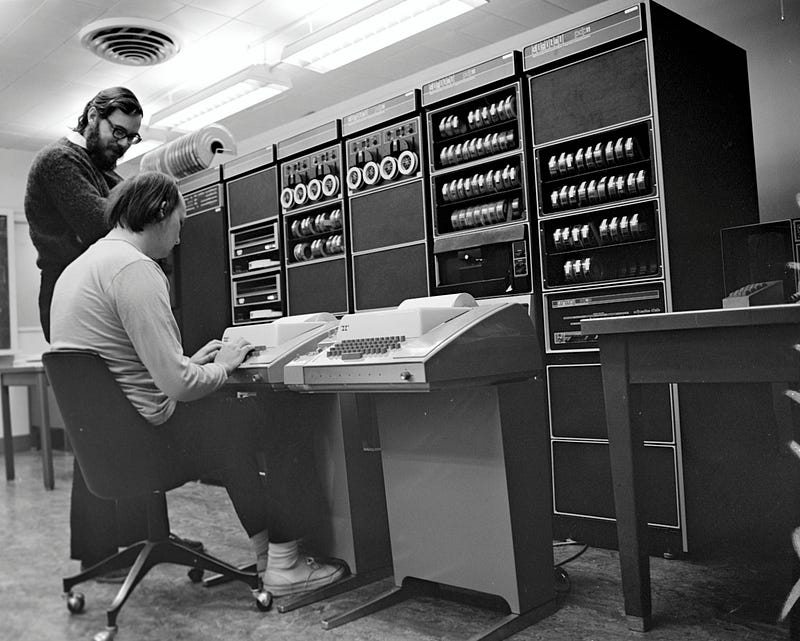
The year is 1969. The counterculture revolution in America (and worldwide) reaches it’s peak with the Woodstock Music and Arts Festival in Bethel, NY with famous music artists like Jimi Hendrix, Jefferson Airplane, The Who, Crosby Stills Nash and Young, and the Grateful Dead taking part in the over half a million person peaceful gathering. Anti-war protests rattle the country over the United States’ military occupation of Vietnam, causing the country to become even more divided. The Cold War was brimming to a boiling point. However, even with all of this going on, the U.S. had also accomplished the unthinkable — landing a man on the moon for the first time in human history. There was no doubt that the 1970s would start on a groovy note, however, you likely won’t read about many of the most important technological innovations of the time in your average history class.
In 1969, an engineer and systems expert at AT&T’s Bell Laboratories found himself without work (and quite bored) as the project that he and his team had been working on, the Multics (Multiplexed Information and Computing Service) time-sharing operating system, had crumbled before his eyes. In the time planning his next pursuit, Ken Thompson found himself creating and playing computer games on the company’s expensive GE 635 mainframe, which he had access to from working on Multics. One of his games in particular, Space Travel, was loved by Ken, and who could blame him with all that was going on in the world at the time regarding the endless possibilities of outer space?

However, fearing that his use of the mainframe would be looked down upon by his superiors, Ken decided to attempt to port the game to an older computer he had found in Bell Labs, a Digital Equipment Corporation (DEC) PDP-7 that was basically left abandoned as it was already considered an obsolete machine at the time. In order to port the game to the more efficient and less expensive PDP-7, Ken designed his own operating system, which drew heavy inspiration from the Multics project. While still having access to the Multics environment, Ken began writing a new file and paging system on it.
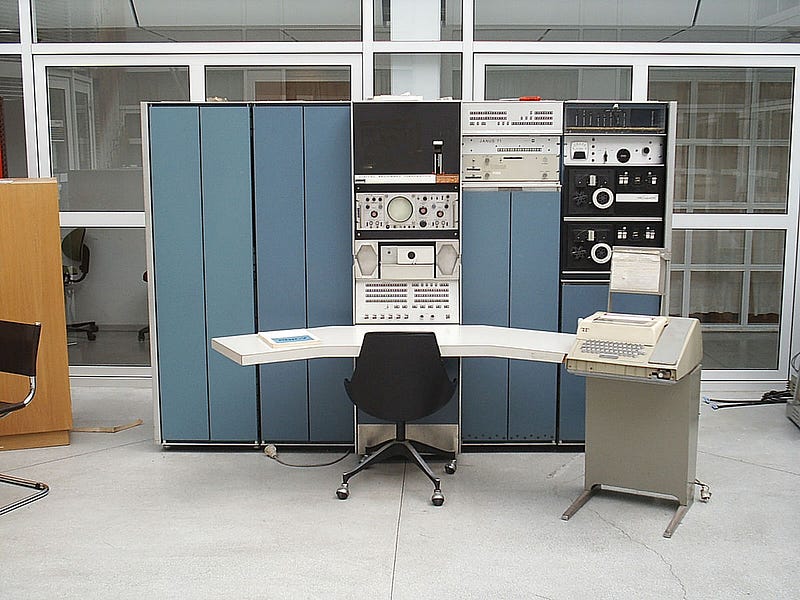
By the time late 1969 had rolled around, Thompson, along with former Multics colleague, Dennis Ritchie, built a team of Bell Labs engineers to design a simpler and more efficient version of Multics, which included a hierarchical file system, computer processes, device files, a command-line interpreter, and some smaller utility programs. This new operating system would form the base of what would eventually become the first version of Unix, released in 1970. In programmer humor, the operating system was first named Unics (pronounced “eunuchs”) for Uniplexed Information and Computing Service — a pun on the Multics acronym. No one actually remembers how the final name came to be Unix (Copyrighted by AT&T as UNIX).
In a period of about three years, Unix underwent multiple changes and three rewrites, resulting in Version 1, Version 2, and Version 3. In 1973, Dennis Ritchie’s C programming language compiler had become powerful enough to start developing critical software in it. With another complete rewrite of the Unix system (Version 4), C became the heart of Unix and remains one of the most prolific programming languages in history and is still heavily used today and essential for building diverse types of software. In fact, Unix and C became so tightly intertwined with each other, that later developments included shaping the operating system and programming language in specific ways to fit each others needs. By the time Version 4 was released, Unix had spread throughout Bell Labs like wildfire.
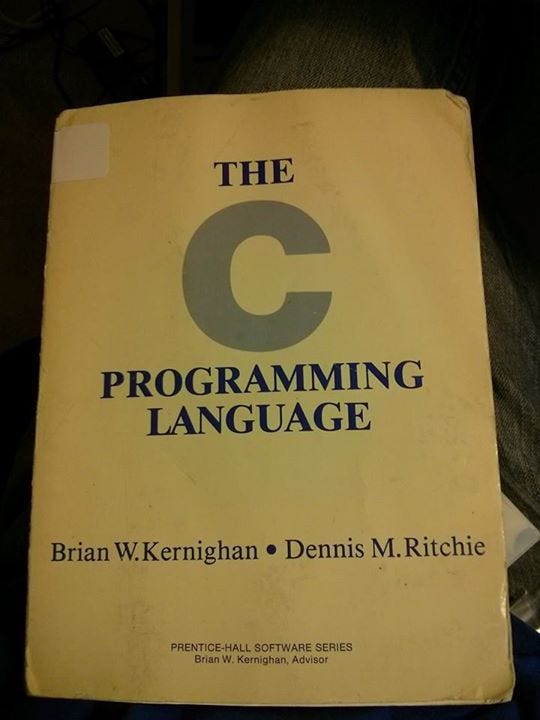
In 1973, Unix made its first appearance into the world outside of Bell Labs as Ken Thompson and Dennis Ritchie spoke about the system in a presentation at the Symposium on Operating System Principles. Later that year, after many requests from outside organizations to use the system, Version 5 was released via special licensing by AT&T to academic institutions throughout the United States. Version 6 debuted in 1975 and became the first commercially available Unix system.
However, when Unix found its way to the University of California, Berkeley in 1974, things would take a dramatic turn in the Unix world. Bob Fabry, a highly-acclaimed computer science professor at the institution requested Unix Version 4 after seeing it presented at the Symposium the year before. When Ken Thompson took a sabbatical from Bell Labs and wound up at Berkeley’s computer lab, he helped to install Unix Version 6 on a new PDP-11/70 and began working on a Pascal implementation for the system, which was in turn improved upon by two graduate students, Chuck Haley and Bill Joy. Due to interest from other universities, Joy ended up compiling the first Berkeley Software Distribution (1BSD), which was an addition to Unix Version 6, not a complete operating system by itself, and released it in March 1978, sending out approximately thirty copies.
In 1978, the final version of Research Unix at Bell Labs to see mainstream use was released as Version 7. Due to the collaborative nature of the Unix system, many different sections of Bell Labs began altering the source code for their own needs and use cases, resulting in a plethora of different in-house Unix versions including CB UNIX, MERT, and PWB.
Unix began to gain prominence in commercial organizations when the top engineers and computer science graduates were hired by rising technology companies and brought the operating system with them. Due to the flexibility, portability, and power of Unix, many thought that it would become the universal operating system, partly due to the fact of its implementation in C, which allowed it to outlive specific hardware architectures in a way that operating systems written in specific assembler languages could not.
A myriad of commercial versions of Unix began to appear in the early 1980’s including Onyx System’s Microcomputer Unix and Santa Cruz Operation (SCO) and Microsoft’s Xenix. In 1981, Bell Labs released a new version called UNIX System III, that was based on it’s predecessor, Version 7. In the backlash of the anti-trust case that AT&T lost against the U.S. Department of Justice, AT&T moved quickly to attempt to push out their seminal Unix system against all competitors.
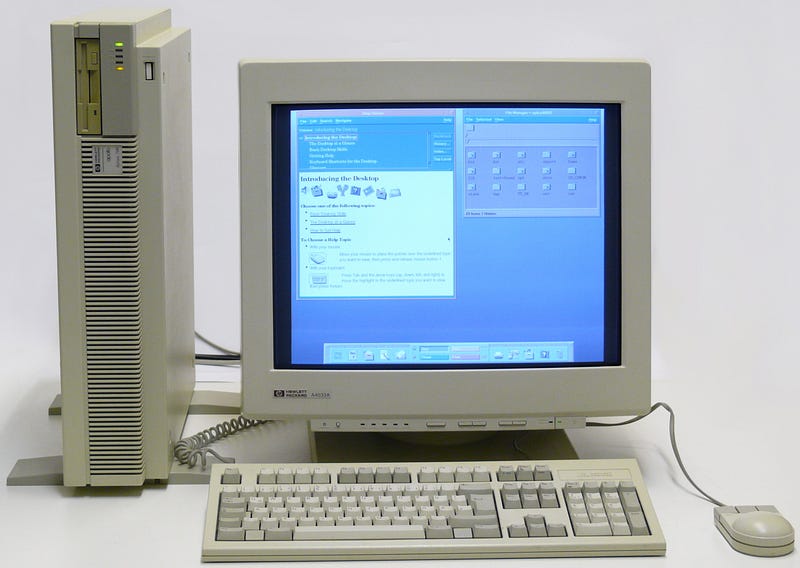
In 1983, the company was tired of the confusion between all of their internal versions of Unix and merged them into the what became known as UNIX System V (pronounced “System Five”). In addition to the software included in those flavors, System V also picked up some software from BSD, most notably the vi text editor and curses. Also in 1983 — Richard Stallman founded the GNU Project in retaliation to AT&T’s newer commercial UNIX licensing terms. The GNU Project believed in freedom to use a computer however one would like, including the software available. They began rewriting many popular Unix programs in order to bypass the UNIX copyright and distribute the system to anyone for free.
From 1979 to 1983, Bill Joy and company continued work on the BSD system, releasing versions 2BSD, 3BSD, 4BSD, and 4.1BSD. During this time-frame, he also founded what would become a tech powerhouse in Sun Microsystems, which created a BSD variant known as SunOS for their workstations. In order to oversee the development of 4.2BSD, Duane Adams of DARPA formed a committee including Bob Fabry, Bill Joy, Sam Leffler, Rick Rashid, and Dennis Ritchie, among other high-profile computer scientists. Version 4.2BSD hit the scene in August 1983 and became the first version released since Bill Joy left for Sun Microsystems. In turn, Mike Karels and Marshall Kirk McKusick became the BSD project leaders.
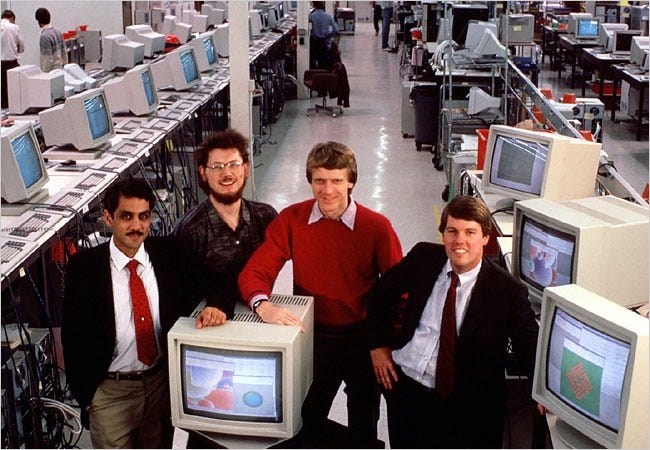
The latter half of the 1980s saw Unix become popular outside of academic and technical circles. It became viable in unexpected places like large commercial installations and mainframe computers. Though on the surface, the Unix world may have seemed exciting and innovative, there was a large storm brewing that would turn into what is now known as the Unix Wars, which lasted from the late 1980’s until the mid 1990’s. This war would considerably threaten the viability of Unix and Unix-based systems (like BSD) to break into the mainstream culture.
One of the main stokes of the fire was the lack of standardization within the Unix community — with different distributions like System V, BSD, unique combinations of the two, and Xenix (based on System III), it was a project divided. To rectify this problem, AT&T issued its own standard, the System V Interface Definition (SVID) in 1985 and required compliance for operating systems to use the System V brand.
However, another standardization effort (based on SVID) was released by the Institute of Electrical and Electronics Engineers (IEEE) in 1988, known as the Portable Operating System Interface (POSIX) specification. POSIX was designed as a compromise between System V and BSD and was eventually recognized and implemented for all Unix systems utilized in the United States government, gaining heavy favor and popularity.
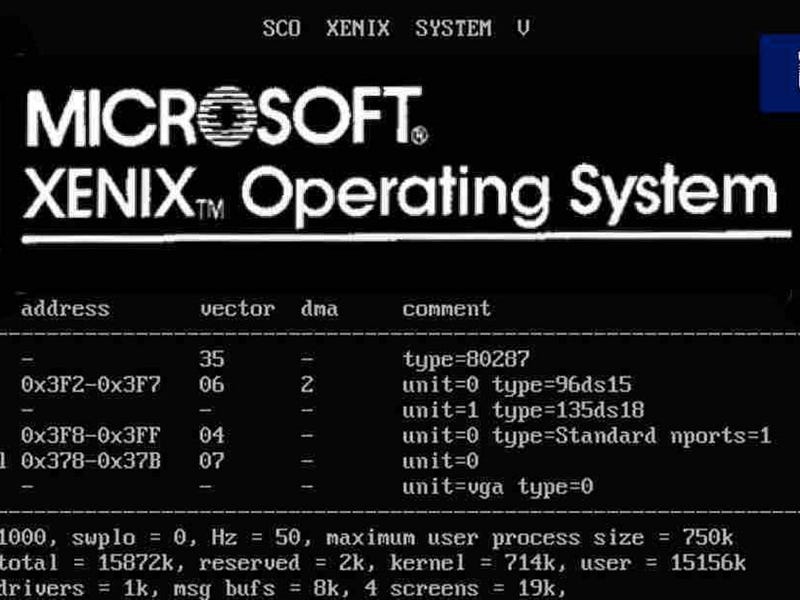
In response, AT&T began to push the envelope even further by first collaborating with Santa Cruz Operation to merge System V and Xenix into System V/386. After that, AT&T joined forces with Sun Microsystems to merge their 4.2BSD derivative, SunOS, with System V and Xenix. The result became the major and comprehensive version known as UNIX System V Release 4 (SVR4). In retaliation, the Open Software Foundation was formed from the sponsorship of what is known as “The Seven” — Apollo Computer, Groupe Bull, Digital Equipment Corporation, Hewlett-Packard, IBM, Nixdorf Computer, and Siemens AG — and began to work on its own Unix unification system, known as OSF/1.
However, even with the attempt at unification by AT&T, Sun Microsystems, and SCO, other major tech companies began basing their own Unix systems off of System V Release 4 with BSD functionalities. Some other commercial versions based on System V include Sun Microsystem’s Solaris, HP’s HP-UX, IBM’s AIX, DEC’s Ultrix, Novell’s UnixWare ,and Cray’s UNICOS. In 1988, Silicon Graphics (SGI) released their IRIX operating system that was based on System V with some BSD extensions for the company’s proprietary Microprocessor without Interlocked Pipeline Stages (MIPS) workstations and servers. This would heavily contribute to SGI’s successes in the graphical computing field, with the most advanced system at the time. In fact, IRIX became one of the most mainstream and popularized commercial versions of Unix during its time due to the quality and cost of SGI’s hardware and the growing interest in digital graphics for video and film.
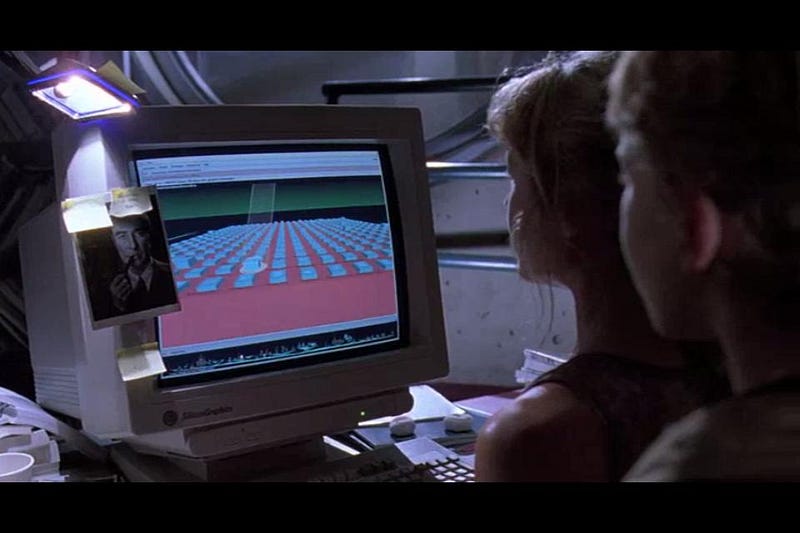
Another popular Unix-like operating system popped up in 1987, known as MINIX, which was designed by Andrew Stuart Tanenbaum for computer science educational purposes and made popular by its companion textbook, Operating Systems: Design and Implementation. However, MINIX deviated further from UNIX than most and it was only considered Unix-like, not Unix-based. The kernel and code was written from scratch using a microkernel architecture, instead of the monolithic kernel found in many Unix and BSD systems of the time. Little did Tanenbaum know, his creation of MINIX would change the history of Unix forever.
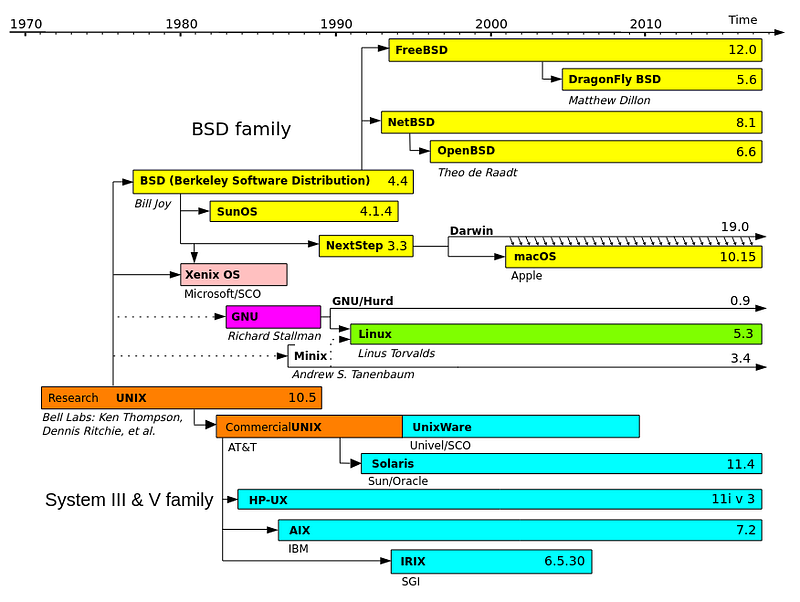
While working at Unisys in 1987, linguist-turned-programmer, Larry Wall, became irritated with the lack of a proper text processing language that had the flexibility and ease of use of the popular awk tool and shell scripts with the performance, portability, and power of the C programming language. To solve his issues, Wall hacked together a simple domain specific language known as the “Practical Extraction and Reporting Language”, or Perl for short.
Wall became interested by the free software movement that was picking up steam, in part due to Richard Stallman and the GNU Project, and saw what the power of releasing source code into the wild for free could provide to a project. Therefore, Wall released Perl into the Unix world, where it quickly blew up and soon became an essential tool in every Unix administrator, developer, or user’s toolbox.
As Perl was developed out in the open with hundreds of developers from all around the world, it grew from a domain specific language into a general purpose programming language. Even today, Perl is one of the first software packages installed in nearly every Unix-like system in existence due to the powerful flexibility and ease of use it provides in bootstrapping large software projects (like the Unix kernel itself).
In the shadows of the Unix Wars, along with the rise of the Free Software Movement (spearheaded by Richard Stallman with the GNU Project and Larry Wall with Perl), a young computer science graduate student from the University of Helinski would forever alter the course of history after releasing the source code for a free Unix-like kernel — partially based on the MINIX system he had learned and used in school — into the free software world in August 1991. His name was Linus Torvalds, and his kernel — Linux.
A ton of research went into compiling this presentation on the history of Unix, and of course, many minor (and even some major) details were inevitably left out. This could truly be the subject of an entire book series. If you feel that I have misinterpreted any of this information or left anything extremely valuable out, please feel free to reach out to me with your corrections and sources so that I can update it and make sure that the information is as accurate as humanly possible for future readers!
I hope you enjoyed this piece and I look forward to releasing Part Two, entitled History of the Unix Family: The Rise of Linux into the world soon!
If you would like to learn more about the very early history of Unix from an extremely in depth and technical perspective, check out Warner Lash’s talk at BSDcan 2020 linked below:
Linux Desktop Setup of the Week
This week’s selection was presented by u/TheMightyShronk in the post titled [i3-gaps] Previous post deleted, guess who’s back again. Here is the screenshot that they posted:
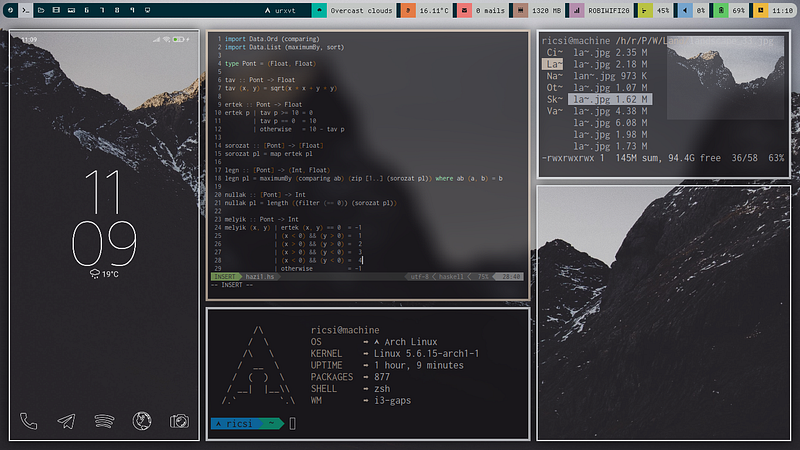
And here are the system details:
OS: Arch Linux
WM: i3-gaps
Terminal: URxvt
Status Bar: Polybar
Composition Manager: tyrone picomp with dual kawase blur
Wallpaper: Landscape_33
Thanks, u/TheMightShronk, for an awesome, unique, and well-themed i3-gaps desktop!
If you would like to browse, discover, and comment on some interesting, unique, and just plain awesome Linux desktop customization, check out r/unixporn on Reddit!
See You Next Week!

I hope you enjoyed reading about the on-goings of the Linux community this week. Feel free to start up a lengthy discussion, give me some feedback on what you like about Linux++ and what doesn’t work so well, or just say hello in the comments below.
In addition, you can follow the Linux++ account on Twitter at @linux_plus_plus, join us on Telegram here, or send email to linuxplusplus@protonmail.com if you have any news or feedback that you would like to share with me.
Thanks so much for reading, have a wonderful week, and long live GNU/Linux!

Be the first to comment at forum.tuxdigital.com